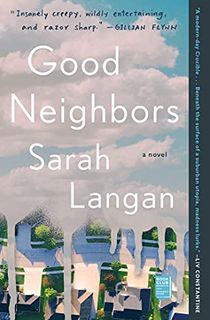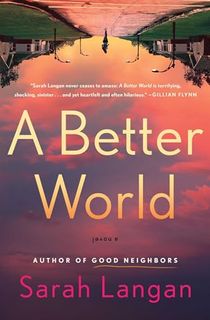Sarah Langan is experimenting with new genres and loving it.
The three-time Bram Stoker Award winner grew up on Long Island, got her MFA in Creative Writing from Columbia University, and received her Master’s in Environmental Health Science/Toxicology from New York University.
Her work has often been included in several best-of-the-year lists and anthologies.
She’s a founding board member of the prestigious Shirley Jackson Awards so naturally, the rich character studies in her horror and society thriller stories harken back to Shirley Jackson and Rod Serling regardless of genre.
Her upcoming novella Pam Kowolski is a Monster will come out later this year and she is prepping a book for 2026, but we took a trip down memory lane to see what dark and light inspirations live there.

The Keeper
According to Sarah Langan, the persistent theme of doubling is central to many of the characters and even the town of Bedford itself in The Keeper.
Bedford was once a thriving paper mill town in Maine like the one Langan witnessed while in college in Waterville, Maine. Its hulking factories are relics of industry and sit like cavernous tombs on the horizon.
“I thought it was a really cool symbol for sort of this change in the American economy, and I was thinking a lot about that,” Langan said.
Her viewing of François Truffaut’s 1966 film adaptation of Fahrenheit 451 also got her thinking about doubles since the lead actress Julie Christie plays Montag’s wife and love interest.
The sleepy mill town Bedford is fascinated with local beauty-turned-whore Susan Marley. After Langan finished the novel in a blast of creativity as a twentysomething she discovered during her revisions that The Keeper’s sisters Liz and Sharon were conceivably the same person in a way.
“This story is really a journey,” Langan reflects. “This internal journey of coming to terms with the sisters’ shared background.”
In the end, Langan is happy that she took up to eight years to sell her first novel during her twenties.
“I'm immune to learning lessons is the problem,” she laughed. “I cannot take a note. I try. The older I get, the better I am at it. The thing is sometimes you're living in the right time for what you're doing, and sometimes you're not.”
She could have written a paranormal romance novel or some Bridget Jones’ Diary-like book, but that would have meant abandoning her first book, and we’re all glad that did not occur.

The Missing
The Keeper's sequel is called Virus in the UK, and The Missing in the U.S. Both are appropriate names for a story set in the wake of an environmental disaster.
Set in a secluded and affluent Maine community, Corpus Christi, The Missing continues the doubling theme since the blue-collar town of Bedford was destroyed in The Keeper.
“I remember feeling very free and also terrified because I was going to school for toxicology [from New York University] at the same time, so I was in school full time, and then I had this novel due in 13 months.”
Despite the deadline hanging over her head, Langan thoroughly enjoyed writing a vampire/zombie origin tale that kicks off during a third-grade field trip to Bedford. There in the abandoned woods, a barbaric boy unleashes a contagious plague.
"The Keeper felt to me the story of the kids and their frustrations,” Langan said.
“The Missing for me is the story of the parents and just sort of flipping it over and saying, ‘well, what are they feeling about this strange world that we inhabit?’ I'm just going to write this metaphor on capitalist consumption and just have a ball killing people. It was really fun. I remember watching Slither and getting mad at the time since it was the same damn thing that I’m doing,” Langan laughed.
It worked out well on the other side. The Missing started Langan’s Bram Stoker Award win streak in the mid-aughts that continued with her short story “The Lost,” and the haunting 2009 novel, Audrey’s Door.

The Lost
“The Lost” is about a sales girl slowly disintegrating in New York City and Sarah Langan felt directly inspired by her neighborhood while writing the story in her late twenties and feeling frustrated about her writing career while in a writing group called Who Wants Cake.
“I shared a house on a dead-end street between two projects. And even in the daytime, it wasn't safe to go there,” Langan remembered.
“I had printed up manuscripts of The Keeper that I was going through, and I put it out for recycling. One night my roommates were out of town, so it was just me in this terrifying house. And I woke up to someone smoking crack under my window, and I came out and it was this naked man or maybe just had underpants on, and he had torn my manuscript into tiny pieces all over my lawn."
Langan was terrified at the time since after the cops came and took the man away he eventually came back and started smoking crack again under her window.
“Life is hard,” Langan joked. “I wrote that story as that was happening, and I was just, ‘I feel like I'm invisible and dying.’”
The short story’s claustrophobic prose makes total sense after learning about the story behind the story.

Audrey's Door
Langan wrote a very different type of horror novel after the duology of the visceral styles in The Keeper and The Missing. Her agent and editor sold Audrey’s Door and encouraged her to write something literary—and not just a continuation of her first two novels.
The backlash was huge, downright ugly, and just plain “uncool” as Langan puts it. “In hindsight, I kind of wish I'd stuck up for myself and my book a little bit more, but it's hard to do in the moment,” Langan said. “It's hard because you think ‘maybe they're right’”
Publisher's Weekly at the time called it one of their favorite books of the year and then a new editor came along and got ahold of the book and trashed it on her LiveJournal and gave away the ending in a rage.
“Then people started saying that I had stolen the book, that it wasn't my book, but it was The Sentinel, which I had never seen. And I was like, ‘I don't know what to do about this.’”
Stepping back from the controversies at the time, Langan is still proud of the book that tells the story of “a woman who is broken but doesn't want to be.” Langan also wanted to write about a woman who is a virgin for longer than is acceptable in society and what that must feel like.
Langan realized she should have had thicker skin about the book in hindsight. Audrey’s Door still holds up 16 years later as a beautifully haunting ghost story focused on its characters in the creepy Breviary apartment.
At its center, the up-and-coming architect protagonist Audrey Lucas is endearing and heartbreaking to the last page.

Good Neighbors
Langan put Good Neighbors on the shelf for a while after realizing that she shouldn’t write straight horror for this story since it felt like “a hat on a hat.”
Dropping the traditional monster elements was a terrifying setup on a personal writing side, but she saw plenty of evil within surburbia and narcissistic people.
“I was really interested in these characters under pressure who begin to turn on each other and the nature of scapegoating,” Langan recalls. “They pick the family that doesn't fit, and the family they're really afraid of becoming. I think that's usually why you scapegoat because you're afraid that their lack of money and common sense is contagious.”
Langan enjoyed writing a novel pulled from past experiences after focusing on other projects such as “You Have the Prettiest Mask” for Lady Churchill’s Rosebud Wristlet No. 42 and the short story “Night Nurse” found in the collection Hex Life: New Tales of Witchery.
“[Good Neighbors] is a cautionary tale of those who get hijacked by society, but also the kids that try to avoid that hijacking.”
The author pulled experience from her years growing up in a conservative area of Long Island as well.
Her villainous character Rhea Schroeder is carrying around secrets and a deep loneliness. She thinks she’s rotten and just needs to keep it together as a community college professor and not be discovered in her neighborhood.
As the "Queen Bee" of Maple Street, she lives next door to the Wilde family, who disturbs the peace by acting and looking different from the norm.
Inspired by The Twilight Zone classic episode, “The Monsters Are Due on Maple Street,” she centered Good Neighbors on how a town can sink into evil and mob mentality.

A Better World
A Better World centers on a walled-off company town protecting its citizens from a climate- and war-torn world. The schools win awards and the air is extra clean.
Sure, there are the strange "caladrius," waddling around on lawns, but what could go wrong? The strange flightless birds that were genetically engineered serve as an eerie metaphor for a corporate bell jar life souring in slow motion.
Langan calls the feelings present in the book the type of “gaslighting that occurs from corporate entities or the government onto all of us.”
She sets up two generations that the story is coming from with the parents and the teenage kids.
“What's interesting about now being a parent to teenagers is they're utterly aware of their world and in surprising ways,” Langan noted “You talk to an 11-year-old and they're pretty ignorant of the current events and also the social climate, and they're 13 and they know exactly what the social climate is. So you could go right now to either of our kids and say, ‘What do you think about that guy from United Healthcare who got assassinated?’ They're like, ‘Yeah, we've all talked about that in school today.’ It's an interesting world they inhabit, and I'm sure it's how our parents felt too.”
A Better World is a nerve-wracking and dark thriller that follows the Farmer-Bowens family when they visit Plymouth Valley. The company offers to hire Linda Farmer’s husband, a numbers genius, to this idyllic paradise for the .0001%.
Langan was thinking a lot about COVID and the slow-mo trainwreck that was the climate disaster before and after writing this book.
“When COVID happened, it made me a little bit crazy,” Langan laughed. “Suddenly every kid had to have a Chromebook…and they had to sit for six hours a day with this crap education that was all bought by the school systems online…That’s exhausting! Just let them read a book.”






